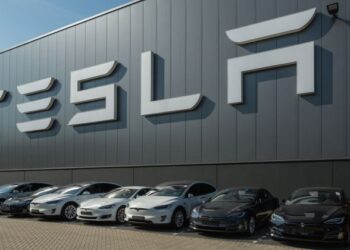Elon Musk is developing plans to launch a new artificial intelligence start-up to compete with ChatGPT-maker OpenAI, as the billionaire seeks to join Silicon Valley’s race to build generative AI systems.
The Tesla and Twitter chief is assembling a team of artificial intelligence researchers and engineers, according to people familiar with the tech entrepreneur’s plans.
Musk is also in discussions with a number of investors in SpaceX and Tesla about putting money into his new venture, according to a person with direct knowledge of the talks. “A bunch of people are investing in it . . . it’s real and they are excited about it,” the person said.
For the new project, Musk has secured thousands of high-powered GPU processors from Nvidia, according to people with knowledge of the move. GPUs are the high-end chips required for Musk’s aim to build a large language model — AI systems capable of ingesting enormous amounts of content and producing humanlike writing or realistic imagery, similar to the technology that powers ChatGPT.
The speed with which Musk is moving will raise eyebrows in some corners of the AI community after he led a letter, cosigned by thousands of other tech figures, calling for a pause on development of GPT-style models over safety concerns.
The billionaire’s potential entry to the hot generative AI market will add yet another venture to his diverse portfolio of responsibilities and investments. This already includes running Twitter and Tesla, as well as founding SpaceX, his $137bn rocket maker, Neuralink, a neurotechnology researcher, and The Boring Company, a tunnelling start-up.
Musk is recruiting engineers from top AI labs including DeepMind, according to those with knowledge of his plans, who said he began to explore the idea of a rival company earlier this year in response to the rapid progress of OpenAI.
Musk has so far brought on Igor Babuschkin, a former DeepMind employee, and roughly half a dozen other engineers. The Information previously reported Babuschkin’s early talks with Musk.
The new company would allow Musk to take on OpenAI, the Microsoft-backed group that he co-founded in 2015. He left the board three years later amid clashes with its management, including over attitudes to AI safety, according to two people who were involved in OpenAI at the time. Shortly afterwards, the organisation morphed into a for-profit start-up and raised a $1bn investment from Microsoft.
Since then, Musk has become increasingly vocal in his fears of broader existential threats from AI systems. He has also publicly criticised OpenAI for becoming, in his view, less transparent and too commercially minded in its pursuit of advanced AI. Musk is particularly concerned about the threat of models like GPT-4, OpenAI’s latest release, to spew falsehoods and show political bias.
During a Twitter Spaces interview this week, Musk was asked about a Business Insider report that Twitter had bought as many as 10,000 Nvidia GPUs, “It seems like everyone and their dog is buying GPUs at this point,” Musk said. “Twitter and Tesla are certainly buying GPUs.”
People familiar with Musk’s thinking say that his new AI venture is separate from his other companies, though it could use Twitter content as data to train its language model and tap Tesla for computing resources.
While the AI team’s exact position in Musk’s corporate empire remains unclear, he recently moved Twitter Inc, which he bought for $44bn last year, into a new holding company, X Corp.
A Musk-backed generative AI venture would enter an increasingly crowded and well-financed market. Tech giants Microsoft, Google and Amazon are jostling with start-ups such as OpenAI, Anthropic, Adept and StabilityAI, who have together raised billions of dollars in recent months.
When Musk left OpenAI in 2018, the public explanation for the split was that he wanted to focus on Tesla, which was also investing heavily in AI.
“Tesla was competing for some of the same people as OpenAI & I didn’t agree with some of what OpenAI team wanted to do,” Musk tweeted in 2019, adding that it was “better to part ways on good terms”.
People involved in OpenAI at the time of his departure say that Musk clashed with other board members and staffers, including differences between his and the company’s “choices” regarding AI safety.
Another person who was involved in the company at the time, described a tense all-staff meeting in 2018 to explain Musk’s departure. “The highest morale moment [for the business at that time] was the happy hour we hosted after parting ways with Musk,” the person said.
Musk and OpenAI did not immediately respond to requests for comment.











